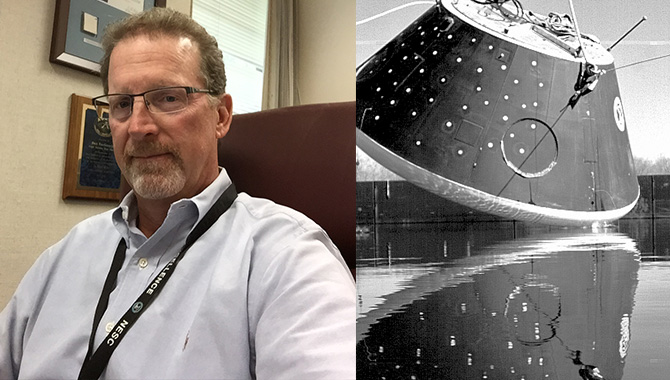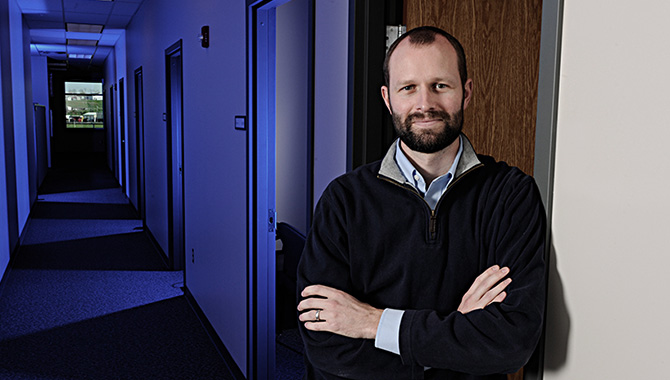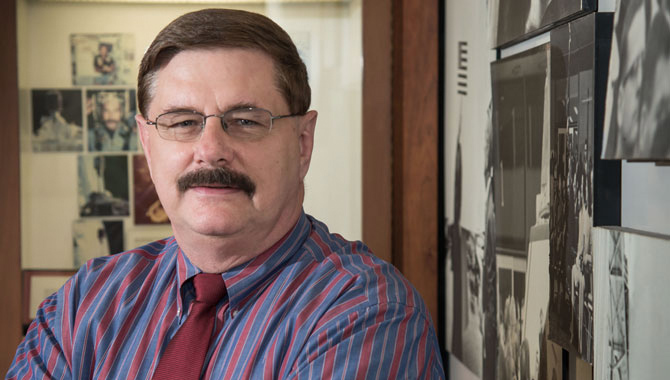
NESC CKO Dan Yuchnovicz, left, and the boilerplate Orion crew module, which helped gather water impact test data used by the NESC. The module was painted black to use a highly accurate photogrammetry technique for position and attitude tracking.
Photo Credit: NASA
Dan Yuchnovicz discusses knowledge sharing at the NASA Engineering and Safety Center.
Disclaimer: This material is being kept online for historical purposes. Though accurate at the time of publication, it is no longer being updated. The page may contain outdated information or broken links. Current Knowledge Community Corner articles are available here.
Dan Yuchnovicz is the Chief Knowledge Officer (CKO) for the NASA Engineering and Safety Center (NESC). Prior to joining NASA in 2002, Yuchnovicz spent more than 20 years in industry as a systems engineer working for Department of Defense (DOD) contractors. He holds a bachelor’s in electrical engineering and a master’s in systems engineering. Yuchnovicz, a systems engineer at NASA’s Langley Research Center and a member of the center’s Lessons Learned Committee, is responsible for knowledge sharing of technical information gained from NESC work.
The NESC was established in July 2003 in response to the Space Shuttle Columbia accident and provides independent assessment of technical issues for NASA programs and projects. The NESC focuses on technical rigor and engineering excellence, and uses an institutionalized tiger team approach to solving problems. NESC assessment teams are typically formed and led by agency-recognized NASA technical fellows who draw talent from their technical discipline teams, which offer a pool of ready expertise. Much of the NESC work includes testing and analysis to provide second opinions that are based on data.
What are some of the most prominent knowledge challenges in your organization?
Unfortunately, many lessons are repeated — what we call ‘lessons noted, but not learned.’ Each generation or project seems to relearn past lessons as a part of their maturing. This is costly and time-consuming, and we are constantly, as a community, working to improve upon this. I think the biggest challenge for knowledge managers is how to get the right information to the right people at the right time in the development cycle, in addition to being aware of knowledge that is worthy of capturing during the development cycle. How do you infuse remedies or recommendations derived from lessons learned into the workforce? How do you know where the real nuggets of knowledge are when we have between 80 and 100 assessments open at any given point in time? How do we increase awareness of broadly applicable engineering knowledge that we collect and publish from our assessments? These are our daily challenges.
Are there any successful knowledge efforts in your organization that you’d like to highlight?
We have several knowledge efforts within our assessment work and others on behalf of the NASA technical fellows. Our engineering reports are the key knowledge product produced by NESC assessment teams, and that drives our knowledge capture and knowledge product development. Two key products captured from assessments are lessons learned and NESC technical bulletins. Some assessment-specific lessons remain captured within the assessment report, but broadly applicable lessons are elevated to the NASA Lessons Learned Information System. Additionally, we sometimes see the opportunity to pass on new engineering knowledge or best practices in the form of NESC technical bulletins. The technical bulletins are easy-to-read, one-page summaries of the new engineering knowledge or best practices with references to further information. Another product is a year-end summary of NESC assessment work called the NESC Technical Update. It serves as a primary communication tool for prospective users of NESC services and informs engineers of difficult technical issues faced by the agency and potential solutions.
Another prominent knowledge activity is the NESC Academy, which offers online video, training courses and webinars from senior technical experts to share critical competencies required for NASA missions. The Academy is unique in that it allows the public to access a large portion of the library while at the same time protecting content that is export-controlled and available only to NASA employees and NASA contractors with the proper credentials. The Academy’s presentation style is to have multiple screens providing both presentation material and presenter windows. Presenter bios and, most importantly, presentation materials for each video are downloadable. The NESC Academy online has surpassed 50,000 lifetime views, including 20,000 for FY 2016. By way of comparison, FY 2015 had 13,838 views and the three previous years had 15,803 views combined. We are increasing our number of live webcasts and beginning to experiment with providing a video summary of each of our paper-based knowledge products to increase awareness of content.
Finally, each NASA technical fellow leads a technical discipline team and has a responsibility for being a steward of their discipline. Tech fellows sponsor live webcasts through the Academy and also give noted experts in the field a platform to present knowledge and experience gained over decades of working on difficult problems.
Is there a best or leading practice on how to assign personnel with explicit responsibility to capture, evaluate and share critical knowledge?
To gain insight into how we do that, we need to understand the processes of developing and vetting NESC assessment reports. First, our assessment teams are drawn from multiple technical disciplines to gain multiple perspectives into our proposed solutions, so that it’s not just one discipline looking at a problem and offering a solution. Second, all of our reports typically contain recommendations for the stakeholder. These are peer reviewed by the NESC leadership team, which includes the NASA technical fellows, at the weekly NESC Review Board. Multiple disciplines make up the review board and so offer different perspectives on the solution, which we feel provides a more robust approach to capturing knowledge. Each assessment report contains a section to explicitly include lessons learned during the assessment, which is reviewed by the board. The need to publish a technical bulletin is also identified by either the NESC Director or the review board during the peer review process. So from one perspective, the entire NESC is evaluating our assessment reports for lessons learned and technical bulletins on a weekly basis. But in the spirit of ‘if it’s everybody’s job, it’s nobody’s job,’ our NESC Integration Office is specifically charged to review all assessment reports and will initiate discussion about potential lessons learned and technical bulletins. Knowledge capture is built into our processes.
Over time, as we have captured lessons learned and recommendations in our assessment reports, we’ve begun thinking, ‘Haven’t we seen this before?’ So we initiated efforts to data-mine and trend the more than 1,900 recommendations and 100-plus lessons learned from our assessment reports. We’ve produced more than 600 reports over our 14 years of operation. We’ve started looking for trends across time as to what kinds of recommendations we are making to stakeholders and programs. For example, we are looking to determine if we make the same type of recommendation repeatedly. If it’s a deficiency in the discipline, such as lack of analysis capability, we can bring that issue to the attention of a technical fellow — for that discipline area — who serves as the steward of the discipline. We believe there is much to be learned from this effort.
We also work with the NASA technical fellows and other NESC personnel to capture critical knowledge that is featured in the annual NESC Technical Update. These articles capture some particular aspect or problem faced by the technical discipline. They are presented in somewhat of an interview style, so you hear directly from the tech fellow as to what the problem is, why the problem is important to NASA, and how the NESC and the technical fellow’s technical discipline team is contributing to problem solutions or advancing the discipline. For example, the NASA tech fellow for guidance, navigation and control wrote a feature on how NASA is working with industry and the DOD to either repurpose or continue to collect science data from satellites that have experienced failures in critical parts of their pointing control systems through the innovative use of remaining control capabilities. Kepler was the most noted example.
Are there knowledge management efforts within NASA that you find particularly remarkable or innovative?
The space shuttle knowledge portal is a notable achievement. Unfortunately, after the Apollo program finished, engineers of that era told me how they were instructed to make room for shuttle development by getting rid of their Apollo material. However, many engineers decided to save their detailed engineering reports. The NESC brought several of these Apollo-era engineers out of retirement during the Constellation Program to glean knowledge about the issues faced in many disciplines and subsystems. We recovered many Apollo engineering reports thought to be gone. This was a NASA-wide effort at that time, not just the NESC, and it shows that preserving engineering reports, especially those that contain test data, is important. We have used Apollo test data in current analyses of capsule landing systems and parachute performance.
Are you observing any trends or cultural shifts that affect knowledge management going forward?
I think the biggest one we’ve discovered is that as you bring in the millennials, the early career engineers favor ways of learning that weren’t available to someone like me who came through the university education system in the 70’s. And that is this concept of online or distance learning. Recorded video lectures are commonplace. It seems to be the way that younger people are more willing to learn. Whereas I may have a tendency to want to have a piece of paper in my hand and read a report, other people would rather click on a video link and watch a lecture or look at some neat graphics. I think the online presentation of content is becoming one of the more predominant ways of sharing knowledge because the younger people are used to doing their classes online, so this is a natural environment for them. If they need to go learn about a specific subject, they can pull up a couple of video lessons and at least get a quick primer.
What’s the biggest misunderstanding that people have about knowledge?
There are probably more than I can cite or am aware of, but it depends on the perspective. Some think knowledge capture is difficult. Our experience is that providing modest resources to facilitate the capture process, such as via an interview, eases the perceived burden on the expert to transfer their knowledge at least into an information form that can be captured and preserved. Also, there’s the perception that once we have collected a lesson learned, for example, all of NASA has knowledge of it. Infusing knowledge into the workforce is still the problem, and we’re trying to find better ways to make knowledge available at the right place and right time.









